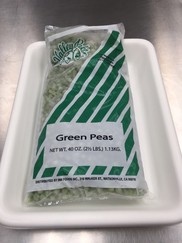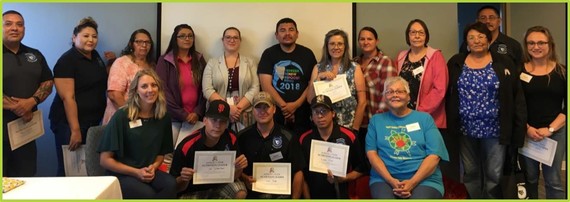
FDPIR Nutrition Paraprofessional Training Project Announcement
FNS is excited to announce the Oklahoma Tribal Engagement Partners (OKTEP) as the selected awardee for the Food Distribution Program on Indian Reservations (FDPIR) Nutrition Paraprofessional Training Project. OKTEP was selected to plan, design, and implement a nutrition education curriculum that will be used to prepare local FDPIR staff to provide basic nutrition education sessions and activities to FDPIR participants.
OKTEP has an established history of program development, implementation, and evaluation collaborations throughout Indian Country and has worked extensively with SNAP-Ed tribal programs. During this two-year cooperative agreement, OKTEP will work closely with FNS to design and implement a nutrition training curriculum that is culturally appropriate and enhances nutrition education opportunities for FDPIR participants. We look forward to working with OKTEP over the next two years and intend to host the first FDPIR nutrition paraprofessional training class in October 2020! We will provide further details on training locations and dates in the coming months.
|
FY19 FDPNE Grant Awards Announced
Congratulations to the 14 Indian Tribal Organizations (ITOs) who received a Fiscal Year 2019 Food Distribution Program on Indian Reservations Nutrition Education (FDPNE) Grant! The overall goal of the FDPNE grant program is to improve the likelihood that persons eligible for FDPIR will make healthy food choices consistent with the current Dietary Guidelines for Americans and USDA MyPlate Guidance. In September 2019, USDA awarded a total of $983,695 to fund 14 nutrition education projects.
View the 2019 grant recipients and project summaries here.
FDPNE awardee Lummi Tribe conducts a cooking demonstration of "homemade hamburger helper" with less salt and featuring healthy foods found in the FDPIR food package.
Grain Category Consolidation
Coming soon, cornmeal, flour, and bakery mix will be combined into one category in the FDPIR Monthly Distribution Guide Rate to provide participants with greater variety and flexibility.
Under the new Guide Rate participants will have the option to choose 2 units of yellow cornmeal, blue cornmeal, all-purpose flour, white whole wheat flour, or bakery mix. There is no limit on flour, cornmeal, or bakery mix selection up to the maximum guide rate of 2 units. By consolidating these items, 1 unit was added to the vegetable category, allowing participants to select up to 12 units of vegetables per person per month instead of 11 units of vegetables.
This category consolidation does not impact dry cereal, oats/farina, pasta/rice, or crackers/tortillas in the grains, cereal, rice, and pasta category categories.
The example below provides a visualization of how participants will be able to select flour, cornmeal, or bakery mix under the new FDPIR Monthly Distribution Guide Rate:


Frozen Peas Coming Soon to FDPIR Programs!
Based on feedback from the FDPIR Food Package Review Workgroup, frozen green peas will be added as a new option in the FDPIR vegetable category.
Frozen peas can be heated and served as a side dish, mixed with other vegetables, added to rice, included in pasta recipes, or used in soups. Peas are a good source of fiber, vitamin A, and vitamin C. Similar to the frozen blueberries added this year, frozen peas are an individually quick frozen (IQF) product.
Frozen peas will be available in a 2.5 lb. bag and one bag of frozen peas will count as 3 units, just like the frozen blueberries. Green peas are the first frozen vegetable option available to FDPIR customers and are offered in addition to the variety of fresh and canned vegetable choices. For more information about this product and for recipe ideas, please refer to the USDA Foods fact sheet.
Due to the grain category consolidation, participants will be allowed to take 12 units of vegetables per person per month, instead of 11 units. Participants may continue to:
- Substitute 1 can of vegetables for 1 pound of fresh vegetables.
- Substitute 1 pound of vegetables for 1 pound of fruit up to 5 pounds of fruit per person per month.
If 5 pounds of vegetables are substituted for 5 pounds of fruit, the participant would be able to take 15 units of fruit and 17 units of vegetables.
The example below provides a visualization of the changes to the vegetable category under the new FDPIR Monthly Distribution Guide Rate:
|

IQF Fruits and Vegetables: Best Practices
Individually Quick Frozen (IQF) fruits and vegetables can be easily added to any recipe and since they are frozen, they have a longer shelf-life compared to fresh fruits and vegetables! Here are a few tips on how to properly store and use IQF products:
Storage Tips for Using IQF Frozen Fruits and Vegetables:
- Store unopened frozen fruits and vegetables in the freezer.
- For best quality, store unused portion (after opening) in a sealed air-tight container or freezer safe bag to keep out moisture and reduce freezer burn.
Tips for Using IQF Frozen Fruits and Vegetables:
- IQF products are individually-quick frozen, which means, you can open the package, take as much or as little as needed, close the bag and put the rest back in the freezer.
- Frozen blueberries and peas may be stuck together when removed from the freezer. Use your hands to gently break the peas or blueberries apart in the package before taking out the amount needed.
- Frozen blueberries and peas can be thawed in the refrigerator or they can be thawed during cooking.
- Always cook frozen peas according to the cooking instructions on the package before serving, even if the peas will be eaten cold. Use frozen peas in salad, stews, soups, or a stir-fry.
- Use frozen blueberries in baked fruit desserts like breads, cobblers, muffins, or pies. They are also a great addition to fruit salads and smoothies.
- For a quick nutrient boost to your breakfast, add frozen blueberries to cereal, oatmeal, or pancakes.
Update on Rule to Revise the FDPIR Administrative Match Requirement
On September 3, 2019, the FDPIR Revisions to the Administrative Match Requirement Final Rule with Request for Comments was published in the Federal Register, with a comment period of 60 days, from September 3, 2019 until November 4, 2019.
The final rule was effective immediately, upon publication, and implements the 2018 Farm Bill Requirements revising the minimum Federal share of the FDPIR administrative costs from 75 percent to 80 percent. The Rule also revises the administrative match waiver requirements to allow State agencies and ITOs to qualify for a waiver if the required match would be a substantial burden; limits the reduction of any FDPIR benefits or services to State agencies and ITOs that are granted a full or partial administrative match waiver; and allows for other Federal funds, if such use is otherwise consistent with both the purpose of the other Federal funds and with the purpose of FDPIR administrative funds, to be used to meet the State agency/ITO administrative match requirement.
MPRNAC Nutrition Leader Training

The Mountain Plains Region Nutrition Advisory Committee (MPRNAC) held a Nutrition Leader Training in the Blackfeet Community in Browning Montana August 28-29. Tribal Chairman Tim Davis and Tribal Council member Mark Pollock provided a discussion on the history of the Food Distribution Program on Indian Reservations (FDPIR) and the program’s current nutrition education focus.
The Nutrition Advisory Committee partnered with the Indian Health Service (HIS) to provide a food handlers training to the 16 participants from the Blackfeet, Rosebud, Crow Creek, and Spirit Lake communities. In addition, the FDPIR Nutrition Educator and Food Sovereignty Community advocates held sessions on topics including: finding reliable nutrition information, nutrition education program marketing, and the value of networking and coalition building within communities.
The second day of training included a tour of the Blackfeet Food Distribution Site and a hands-on cooking demonstration. Cooking demonstrations are a great way to show FDPIR participants how to prepare the nutritious foods included in their FDPIR food package! This training was funded through a USDA Food Distribution Program Nutrition Education (FDPNE) Grant. For more information on the FDPNE grant program visit the FNS website.
|
 |

FNS Staff Visits Two Tribes in Oregon
FNS National and Regional Office staff recently visited Klamath Reservation in Klamath Falls, Oregon, and the Burns Paiute Tribe in Burns, Oregon. The opportunity led to productive and informative collaboration between National, Regional, and Local level staff to work together to ensure that FDPIR programs within each tribe run as smoothly and efficiently as possible, while maximizing customer service for program participants.
Chris Tingley (WRO) (left) and Twila Teeman (Burns Paiute Tribe) (right) watch on and offer assistance to Randall Lewis (Burns Paiute Tribe) (center) as he navigates the Automated Inventory System.
Conference Highlights from the 4th Annual Conference on Native American Nutrition
FNS staff attended the Fourth Annual Native American Nutrition Conference, hosted by the Shakopee Mdewakanton Sioux Community (SMSC) and the University of Minnesota in Prior Lake, Minnesota, September 15-18, 2019. This year’s conference was held in conjunction with the Native American Journalist’s Association’s annual National Native Media Conference. During the conference, researchers, practitioners, tribal officials, activist, and journalist gathered to share their knowledge and research on improving Native American nutrition as well as programs to restore food sovereignty across Indian Country.
FNS conducted a breakout session and partnered with Connie Black, PhD, RD, LD, registered dietitian for the Mississippi Band of Choctaw Indians Food Distribution Program to give a presentation highlighting significant enhancements to the FDPIR food package and how they have positively influenced nutrition education. FNS staff also hosted an exhibit table featuring posters of the foods available through FDPIR and photos of several different FDPIR programs. Through these efforts, FNS and our program partners were able to answer questions about FDPIR and help those attending better understand how the program works in their communities.
WBSCM News and Updates
Clipboard Access: As a result of the Web-Based Supply Chain Management (WBSCM) system upgrade in September, WBSCM will not automatically have access to the clipboard when users are copying or pasting information into some fields. Depending on the browser settings, users may be prompted to manually grant permission to the clipboard.
To avoid this message, users (or their local IT administrators) should adjust Internet Options settings for the IE browser to grant permission to the clipboard. Go to Security > Custom Level. Scroll down to the Scripting settings, and enable Allow Programmatic clipboard access.
New Receipting Screen for Direct Shipments: In August, WBSCM has implemented a streamlined process called electronic invoicing (eINV) for materials shipped directly from a commodity vendor. This new process impacts the receipting screen for direct shipments only; there are no changes to receipting multifood deliveries from the National Warehouses.
Although the steps for receipting are essentially the same, separate versions of the work instructions with screenshots and applicable notes are available in WBSCM for both receipting processes:
- For multifood orders and direct shipment orders purchased prior to August 2019, refer to the Enter Domestic Shipment Receipt work instruction.
- For all other direct shipment orders, refer to the Enter and Modify Domestic Shipment Receipt (eINV) work instruction. This includes additional steps for modifying a recently entered receipt, so users can fix typos or update incorrect information without requesting assistance.
Users are encouraged to double-check column headers when entering quantities. When working with the two different receipting screens, columns may appear in a different order than expected. Additionally, the good quantity may be pre-populated with the value from the ASN for eINV-enabled orders.
If you have any questions, please contact the WBSCM Service Desk at WBSCM.servicedesk@CACI.com or call (877) 927-2648.
IFMS News
The Integrated Food Management System (IFMS) is coming! IFMS development activities are underway in preparation to retire and replace the legacy Automated Inventory System (AIS) by consolidating business transactions into an easy-to-use cloud software platform.
IFMS will offer enhanced capabilities to make your job easier such as:
- Multiple search options beyond just the name and social security number
- Dashboard views that allow you to create tasks and view important information such as expiring certifications
- Ability to check across all the Indian Tribal Organizations (ITOs) for duplicate participants
To keep up with progress on this project, refer to minutes from the most recent IFMS Advisory Committee meeting. Additional information about the great features IFMS offers, training opportunities, and the release schedule will be shared over the upcoming months.
If you have questions or suggestions about IFMS, please contact Linda.Munday@usda.gov.

System Reminders
- 12/20/2019 – AIS Release 12.2019
- 12/20/2019 – WBSCM Enhancement Release 2019R4.4.12
- 1/12/2020 – FFAVORS Release 2.10
Planned dates for system activities are subject to change.
|
|